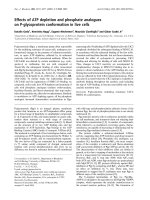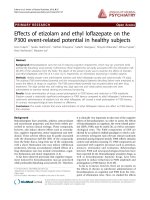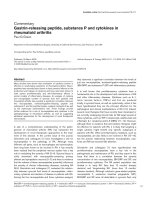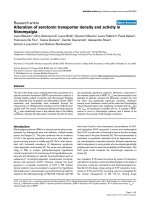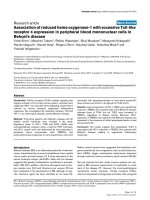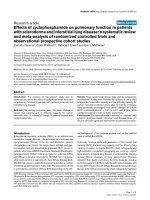Báo cáo y học: " Effects of disease modifying agents and dietary intervention on insulin resistance and dyslipidemia in inflammatory arthritis: a pilot study" pptx
Bạn đang xem bản rút gọn của tài liệu. Xem và tải ngay bản đầy đủ của tài liệu tại đây (62.74 KB, 7 trang )
Introduction
Rheumatoid arthritis (RA) patients are at increased risk for
cardiovascular disease (CVD), comorbidity, and death
[1,2]. Comprehensive cardiovascular risk assessment
comprises both determination of lipoprotein profiles in the
individual patient and identification of other components of
the metabolic syndrome [3].
In RA and other inflammatory arthritides, the acute phase
response is associated with low low-density lipoprotein
(LDL)-cholesterol and high-density lipoprotein (HDL)-
cholesterol, as well as insulin resistance [4–8]. Subtle dys-
lipidemia predicts atherosclerosis in RA [9]. The acute
phase response, body mass index (BMI), insulin resistance,
HDL-cholesterol, triglycerides, and blood pressure interlink
in this condition in the same manner as they do in the meta-
bolic syndrome [6,7]. Also, C-reactive protein (CRP) may
directly contribute to atherosclerosis [10]. Disease-modify-
ing antirheumatic drugs (DMARDs) may have an attenuat-
ing effect on CVD risk and death in RA [11]. In a more
recent report [12], the use of methotrexate in RA was asso-
ciated with a 70% (95% confidence interval 30–80) reduc-
tion in risk for cardiovascular death [12]. Those
investigators postulated that this finding was related to the
profound effects of methotrexate on inflammation.
In the present study, we identified inflammatory arthritis
(IA) patients with active disease who were insulin resistant
BMI = body mass index; CVD = cardiovascular disease; CRP = C-reactive protein; DMARD = disease modifying agents; HDL = high-density
lipoprotein; HOMA = Homeostatis Model Assessment for Insulin Resistance; IA = inflammatory arthritis; LDL = low-density lipoprotein; QUICKI =
Quantitative Insulin Sensitivity Check Index; RA = rheumatoid arthritis.
Available online />Research article
Effects of disease modifying agents and dietary intervention on
insulin resistance and dyslipidemia in inflammatory arthritis: a
pilot study
Patrick H Dessein
1
, Barry I Joffe
2
and Anne E Stanwix
1
1
Department of Rheumatology, Johannesburg Hospital, University of the Witwatersrand, Johannesburg, South Africa
2
Centre for Diabetes and Endocrinology, Johannesburg, South Africa
Corresponding author: PH Dessein (e-mail: )
Received: 26 June 2002 Revisions received: 14 August 2002 Accepted: 16 August 2002 Published: 16 September 2002
Arthritis Res 2002, 4:R12 (DOI 10.1186/ar597)
© 2002 Dessein et al., licensee BioMed Central Ltd (Print ISSN 1465-9905; Online ISSN 1465-9913)
Abstract
Patients with rheumatoid arthritis (RA) experience excess
cardiovascular disease (CVD). We investigated the effects of
disease-modifying antirheumatic drugs (DMARD) and dietary
intervention on CVD risk in inflammatory arthritis. Twenty-two
patients (17 women; 15 with RA and seven with
spondyloarthropathy) who were insulin resistant (n = 20), as
determined by the Homeostasis Model Assessment, and/or
were dyslipidemic (n = 11) were identified. During the third
month after initiation of DMARD therapy, body weight, C-
reactive protein (CRP), insulin resistance, and lipids were re-
evaluated. Results are expressed as median (interquartile
range). DMARD therapy together with dietary intervention was
associated with weight loss of 4 kg (0–6.5 kg), a decrease in
CRP of 14% (6–36%; P < 0.006), and a reduction in insulin
resistance of 36% (26–61%; P < 0.006). Diet compliers
(n = 15) experienced decreases of 10% (0–20%) and 3%
(0–9%) in total and low-density lipoprotein cholesterol,
respectively, as compared with increases of 9% (6–20%;
P < 0.05) and 3% (0–9%; P < 0.05) in in diet noncompliers.
Patients on methotrexate (n = 14) experienced a reduction in
CRP of 27 mg/l (6–83 mg/l), as compared with a decrease of
10 mg/l (3.4–13 mg/l; P = 0.04) in patients not on
methotrexate. Improved cardiovascular risk with DMARD
therapy includes a reduction in insulin resistance. Methotrexate
use in RA may improve CVD risk through a marked
suppression of the acute phase response. Dietary intervention
prevented the increase in total and low-density lipoprotein
cholesterol upon acute phase response suppression.
Keywords: cardiovascular risk, diet, DMARD, inflammatory arthritis
Page 1 of 7
(page number not for citation purposes)
Page 2 of 7
(page number not for citation purposes)
Arthritis Research Vol 4 No 6 Dessein et al.
[6,7] or dyslipidemic [3], or both; who had not taken
DMARDs over the previous 3 months; and who were not
following any dietary recommendations. We re-evaluated
these patients during the third month after DMARDs and
dietary intervention (aimed at improving insulin resistance
and dyslipidemia) were initiated. We tested the following
hypotheses: that DMARDs and dietary intervention attenu-
ate cardiovascular risk; and that those who comply with the
diet and those who use methotrexate experience more
favorable changes in cardiovascular risk than those who do
not comply with the diet and those not on methotrexate.
Materials and method
Patients and investigations
Twenty-two patients, 15 of whom met the American
College of Rheumatology criteria for RA [13] and seven of
whom met the criteria of the European Spondyloarthro-
pathy Study Group for spondyloarthropathy [14], were
identified in our outpatient clinic. Their baseline character-
istics are presented in Table 1.
Patients on lipid-lowering agents or insulin were
excluded. None of the patients had taken DMARDs
during the previous 3 months and none were following
any dietary advice. All had clinically active disease and a
raised CRP. Hypertension was defined as a blood pres-
sure greater than 140/90 mmHg (measured on three
occasions) or prescription of antihypertensive drugs.
None of the patients changed their degree of physical
activity or smoking habits during the study period. Seven-
teen patients were on nonsteroidal anti-inflammatory
agents. The remaining five were either intolerant of
(n = 2) or reported that they did not benefit from nons-
teroidal anti-inflammatory agents (n = 3). Two patients
were taking prednisone (20 mg/day and 5 mg/day). Over
the 2 months following enrolment, those doses were
decreased to 15 mg/day and 2 mg/day.
At enrolment and during the third month after initiation of
antirheumatic agents and dietary intervention, fasting
blood samples (between 0800 h and 1000 h) were
taken. These were used to determine ultrasensitive CRP
(Tina’ quant C-reactive protein latex particle enhanced
immunoturbidimetric assay on Hitachi 917, Roche Diag-
nostics, Rotkreuz, Switzerland); total cholesterol, HDL-
cholesterol, and triglycerides (Olympus Diagnostics,
County Clare, Ireland); LDL-cholesterol (Randox Labora-
tories Ltd, Crumlin, UK); and plasma glucose and serum
insulin (Abbott, Chicago, Illinois). Laboratory testing was
done using autoanalyzers, enzymatic methods (for lipids),
and microparticle enzyme immunoassay on the Axsym
system (for insulin; Abbott Laboratories, Diagnostic Divi-
sion, Abbott Park, IL, USA). The intra-assay and interas-
say coefficients of variance for CRP were 0.43% and
1.34%, respectively; those for insulin were 1.9% and
1.2%, respectively.
Insulin resistance was estimated using the Homeostasis
Model Assessment for Insulin Resistance (HOMA), using
the following formula: insulin (µU/ml) × glucose
(mmol/l)/22.5. Insulin sensitivity was estimated using the
Quantitative Insulin Sensitivity Check Index (QUICKI),
using the following formula: 1/(log insulin [µU/ml]) × log
glucose (mg/dl). In accordance with our findings in a
recent study on healthy volunteers investigated in our lab-
oratory [6], we used a threshold HOMA value of 2.29
(µU . mmol/ml . l) for identification of insulin resistance and
a threshold QUICKI value of 0.337 for identification of
decreased insulin sensitivity.
Disease-modifying antirheumatic drug treatment
At enrolment, we used pulsed methylprednisolone as
bridge therapy as an alternative to oral glucocorticoids
(Table 2) and in view of its reported favorable efficacy and
side-effect profile [4,15–17]. In keeping with previous
reports, methylprednisolone was administered intra-articu-
larly (n = 20) and/or intramuscularly (n = 3) or intra-
venously (n = 4) over 1–3 days. The dose and route of
administration were guided by the number of joints
involved and the perceived level of disease activity
[15–18]. Except for the two patients who were taking oral
glucocorticoids at enrolment, no further patients received
glucocorticoids subsequent to the initial pulsed methyl-
prednisolone therapy. The same parameters and previous
patient exposure to and experience with DMARDs were
taken into consideration when electing to institute
DMARD therapy (Table 2). Eight patients did not receive
methotrexate (Table 2).
Dietary intervention
Dietary recommendation consisted of calorie restriction to
1500 cal/day, carbohydrate restriction to 40% of total
calorie intake, and replacement of saturated by monoun-
saturated and n-3 polyunsaturated fats. The latter consti-
tuted 30% of the calorie intake, and patients were advised
to use canola oil and canola oil margarine, olive oil and
olive oil margarine, avocados, macadamia nuts, almonds,
and peanuts and peanut butter as sources of monounsatu-
rated fats, whereas n-3 polyunsaturated fats were recom-
mended in the form of fish at least four times a week. We
reported these dietary measures previously in gout [19],
and they were shown to attenuate insulin resistance and
have a corrective effect on dyslipidemia. At the second
evaluation, compliance was assessed by questioning
patients about their food intake over the previous week
and confirmed further by body weight measurements. All
compliant patients had lost weight. The seven noncompli-
ant patients (Tables 1 and 2) had not lost or gained
weight (n = 2). Reasons for noncompliance included lack
of motivation (n = 5) and not seeing the need for the inter-
vention (n = 2).
Page 3 of 7
(page number not for citation purposes)
Statistical analyses
Comparisons of medians were made using the
Mann–Whitney U test. Associations were analyzed using
simple linear regression. Analysis of covariance was used
to compare changes in total and LDL-cholesterol between
those who were compliant and noncompliant with the diet,
while controlling for differences in disease duration.
Results are expressed as median (interquartile range).
P < 0.05 was considered statistically significant.
Results
Changes in cardiovascular disease risk in all 22 patients
The baseline clinical and biochemical features, and use of
DMARDs and changes in cardiovascular risk factors in all
22 patients are presented in the second columns of
Tables 1 and 2, respectively. At enrolment, the median
BMI was in the overweight range. The median weight loss
was 4.3% (0–8.4%). The CRP decreased in all except
one patient (increased from 4 to 6 mg/l). Three patients
were known to be diabetic and were on oral hypoglycemic
agents. Another two were found to have fasting hyper-
glycemia (i.e. 7.3 and 7.9 mmol/l) at enrolment. The
glucose level was normal at the second assessment in
each patient, namely 5.5 mmol/l in a patient who was non-
compliant with the diet and 5.1 mmol/l in a patient who
was compliant. Twenty (89%) patients were insulin resis-
tant at enrolment. There was a 36% (26–61%) decrease
in insulin resistance, and only 10 (47%) patients were still
Available online />Table 1
Baseline characteristics in all patients, dieters versus nondieters, and users of methotrexate versus nonusers
All patients Dieters Nondieters Methotrexate No methotrexate
(n = 22) (n = 15) (n = 7) (n = 14) (n = 8)
Age
†
(years) 50 (44–62) 50 (44–62) 50 (43–62) 53 (44–62) 49 (40–62)
Women (n [%]) 17 (77) 12 (80) 5 (71) 12 (86) 5 (62)
Black/Asian/Caucasian/Mixed 1/3/16/2 1/3/11/0 0/0/5/2 0/2/11/1 1/1/5/1
(n/n/n/n)
RA/spondyloarthropathy (n/n) 15/7 10/5 5/2 10/4 5/3
Disease duration
†
(years) 5.5 (0.3–15) 2 (0.25–13) 12 (5–30)* 7 (0.25–15) 5 (0.5–12)
Smoking (n [%]) 5 (29) 1 (7) 4 (57) 2 (14) 2 (25)
Alcohol (n [%]) 6 (27) 4 (27) 2 (29) 4 (29) 2 (25)
Hypertension (n [%]) 10 (45) 6 (40) 5 (57) 9 (64) 1 (13)
Diabetes (n [%]) 5 (35) 4 (27) 1 (14) 3 (21) 2 (25)
Antihypertensives (n [%]) 7 (41) 7 (47) 0 (0) 6 (42) 1 (13)
Antidiabetics (n [%]) 3 (18) 3 (20) 0 (0) 2 (14) 1 (13)
Estrogen (n [%]) 0 (0) 0 (0) 0 (0) 0 (0) 0 (0)
NSAIDs (n [%]) 17 (77) 10 (67) 3 (43) 8 (57) 5 (63)
Prednisone (n [%]) 2 (6) 0 (0) 2 (29) 1 (7) 1 (13)
BMI
†
(kg/m
2
) 27.6 (24.8–33.5) 28.3 (27.1–35.0) 22.2 (21.9–33.2) 27.7 (24.8–35.0) 27.6 (22.2–33.2)
C-reactive protein
†
(mg/l) 22 (10–47) 21 (6–39) 36 (18–71) 31 (11–86) 14 (5–47)
Insulin
†
(µU/ml) 14.9 (10.0–19.3) 14.9 (9.6–19.3) 16 (13.4–20.9) 16.9 (10.2–19.6) 12.8 (9.5–16)
Glucose
†
(mmol/l) 5.3 (4.9–6.3) 5.4 (5.1–7.6) 5.2 (4.6–5.3) 5.3 (5.1–7.3) 5.2 (4.3–6.3)
HOMA
†
(µU . mmol/ml . l) 3.33 (2.56–4.44) 3.29 (2.36–4.44) 3.48 (2.56–4.92) 3.51 (2.71–4.92) 3.00 (2.28–3.48)
QUICKI
†
0.320 (0.307–0.332) 0.320 (0.307–0.336) 0.318 (0.303–0.332) 0.317 (0.303–0.329) 0.324 (0.318–0.337)
Total cholesterol
†
(mmol/l) 5.5 (4.7–6.3) 5.6 (4.7–6.5) 5.3 (4.6–6.3) 5.3 (4.7–6.2) 5.8 (3.7–6.8)
LDL-cholesterol
†
(mmol/l) 3.5 (2.9–4.1) 3.3 (2.9–4.3) 3.7 (3–4.1) 3.2 (2.9–3.8) 3.8 (1.8–5.4)
HDL-cholesterol
†
(mmol/l) 1.19 (0.93–1.50) 1.10 (0.93–1.50) 1.30 (0.91–1.50) 1.05 (0.80–1.60) 1.25 (1.11–1.52)
Triglycerides
†
(mmol/l) 1.6 (0.9–2.5) 2.2 (1.1–3.2) 1.1 (0.9–1.6) 1.9 (1.1–3.2) 1.3 (0.8–2.5)
†
Results expressed as median (interquartile range). Nondieters were compared with dieters, and nonusers of methotrexate with users. *P = 0.045.
BMI, body mass index; HDL, high-density lipoprotein; HOMA, Homeostatis Model Assessment for Insulin Resistance; LDL, low-density lipoprotein;
NSAID, nonsteroidal anti-inflammatory drug; QUICKI, Quantitative Insulin Sensitivity Check Index; RA, rheumatoid arthritis.
insulin resistant at the second assessment. The LDL-
cholesterol remained essentially unchanged. The HDL-
cholesterol increased by 13% (0–25%) and triglycerides
decreased by 26% (11–41%). These changes did not
reach statistical significance. In 11 (50%) patients the
LDL-cholesterol was greater than 3.4 mmol/l, and in seven
(32%) the HDL-cholesterol was below 0.1 mmol/l at enrol-
ment. In three of the patients with a blood pressure
greater than 140/90 mmHg (one of whom was on treat-
ment) at enrolment, blood pressure had normalized at the
second assessment without changing antihypertensive
therapy (one was noncompliant and two were compliant
with the diet).
Weight loss was associated with an improvement in
insulin sensitivity (r
2
= 0.144; P = 0.04), and decreases in
LDL-cholesterol (r
2
= 0.162; P = 0.04) and total choles-
terol (r
2
= 0.242; P = 0.01). The decrease in CRP was
associated with a reduction in triglycerides (r
2
= 0.152;
P = 0.04).
Changes in cardiovascular risk in diet compliant versus
diet noncompliant patients
In the third and fourth columns of Tables 1 and 2, we sub-
divided patients into diet compliant and diet noncompliant
patients. The disease duration was longer (P < 0.006) in
nondieters. Although not significant, there were numeri-
cally more smokers, the baseline median CRP was higher,
and the baseline median BMI was lower in nondieters as
compared with dieters. Changes in CRP and glucose
metabolism were similar in dieters and nondieters.
However, although total cholesterol and LDL-cholesterol
Arthritis Research Vol 4 No 6 Dessein et al.
Page 4 of 7
(page number not for citation purposes)
Table 2
Treatment used and changes in cardiovascular risk profiles in all patients, dieters versus nondieters, and users of methotrexate
versus nonusers
All patients (n = 22) Dieters (n = 15) Nondieters (n = 7) Methotrexate (n = 14) No methotrexate (n = 8)
Treatment used
Pulsed methyl- 200 (160 to 360) 200 (160 to 230) 200 (140 to 730) 200 (160 to 360) 200 (120 to 730)
prednisolone
†
(mg)
Chloroquine (n [%]) 15 (68) 12 (80) 3 (43) 10 (71) 5 (63)
Methotrexate (n [%]) 14 (64) 10 (67) 4 (57) 14 (100) 0 (0)
Minocyclin (n [%]) 9 (41) 7 (47) 2 (29) 7 (50) 2 (25)
Azathioprine (n [%]) 2 (9) 0 (0) 2 (29) 0 (0) 2 (25)
Nonmethotrexate 1 (1 to 2) 1 (1 to 2) 1 (1 to 1) 2 (1 to 2) 1 (1 to 2)
DMARD per patient (n)
†
Changes in cardiovascular risk
Weight
†
(kg) –4 (–6.5 to +0) –4.6 (–8.6 to –4) 0 (0 to 0.8) –3.4 (0 to 8.6) –4 (–6.2 to 0)
C-reactive protein
†
–14 (–36 to –6)* –12 (–36 to –5) –19 (–35 to –13) –27 (–83 to –6) –10 (–13 to –3)***
(mg/l)
Insulin
†
(µU/ml) –4.5 (–8.8 to –2.5)* –3.4 (–7.9 to –1.5) –6.4 (–11.7 to –2.6) –4.5 (–10.2 to –2.9) –4.5 (–6.4 to –1.5)
Glucose
†
(mmol/l) –0.5 (–0.8 to –0.3) –0.5 (–0.9 to –0.3) –0.4 (–0.8 to –0.1) –0.5 (–1.8 to –0.3) –0.5 (–0.8 to +0.1)
HOMA
†
–0.95 (–1.49 to –0.50)* –0.89 (–2.20 to –0.76) –1.45 (–2.92 to +0.82) –1.08 (–2.99 to –0.85) –0.87 (–0.20 to –0.49)
(µU . mmol/ml . l)
QUICKI
†
0.023 (0.014 to 0.049)* 0.021 (0.009 to 0.042) 0.035 (0.023 to 0.046) 0.026 (0.042 to 0.015) 0.022 (0.045 to 0.007)
Total cholesterol
†
–0.05 (–0.9 to +0.5) –0.6 (–1.2 to 0.0) 0.8 (0.2 to 0.9)* 0.0 (–0.5 to +0.7) –0.35 (–1.7 to +0.9)
(mmol/l)
LDL-cholesterol
†
–0.15 (–0.6 to +0.3) –0.3 (–0.8 to +0.2) 0.3 (0.0 to 0.9)** –0.15 (–0.4 to –0.2) –0.05 (–1.5 to –0.8)
(mmol/l)
HDL-cholesterol
†
0.15 (0 to 0.20) 0.20 (0.02 to 0.21) 0.10 (0.00 to 0.51) 0.20 (0.11 to 0.21) 0.06 (–0.11 to +0.50)
(mmol/l)
Triglycerides
†
–0.35 (–1.1 to –0.1) –0.51 (–0.4 to –0.2) –0.21 (–0.4 to +0.2) –0.47 (–1.0 to –0.1) –0.22 (–0.3 to +0.1)
(mmol/l)
Time between 3 (2.5 to 3) 3 (2.5 to 3) 3 (2 to 3) 3 (2.5 to 3) 3 (2 to 3)
assessments
†
(months)
†
Results expressed as median (interquartile range). In the second column, the significance for changes in cardiovascular risk was analyzed.
Nondieters were compared with dieters, and nonusers of methotrexate with users in the other columns. *P < 0.006, ** P = 0.015, ***P = 0.04.
DMARD, disease-modifying antirheumatic drugs; HDL, high-density lipoprotein; HOMA, Homeostatis Model Assessment for Insulin Resistance;
LDL, low-density lipoprotein; QUICKI, Quantitative Insulin Sensitivity Check Index.
increased by 8% (2–9%) and 3% (0–9%) in nondieters,
the respective lipid values decreased by 10% (0–20%)
and 9% (6–20%) in those who complied with the diet.
These differences remained significant after controlling for
differences in disease duration (P < 0.02).
Changes in cardiovascular risk in methotrexate users
versus nonusers of methotrexate
In the fifth and sixth columns of Tables 1 and 2, we subdi-
vided patients into users and nonusers of methotrexate.
Baseline characteristics and the use of antirheumatics
other than methotrexate were also similar in both groups.
No difference in changes in glucose or lipid metabolism
between the groups was seen. However, patients on
methotrexate experienced a 76% (71–94%) decrease in
CRP, as compared with a 61% (28–77%) reduction in
CRP in patients not on methotrexate (P < 0.04).
Changes in cardiovascular risk in users versus nonusers
of chloroquine
Chloroquine users (n = 15) and nonusers (n = 7) did not
differ in baseline characteristics, used treatment (apart
from chloroquine), and changes in lipid and glucose
metabolism and CRP (results not shown).
Discussion
In the present study we found that, in IA patients with
insulin resistance and/or dyslipidemia, the use of DMARD
in combination with dietary intervention was associated
with a marked improvement in insulin resistance and sen-
sitivity, whereas changes in lipid values were not signifi-
cant. The latter may be related to the small number of
cases in our cohort and the relatively short follow-up
period. Thus, a median increase of 0.15 mmol/l in HDL-
cholesterol, as we found, is associated with a reduction by
10–15% in risk for CVD events, which is independent of
LDL-cholesterol concentrations and therefore may still be
clinically relevant [20]. An increase in HDL-cholesterol and
decrease in insulin resistance on DMARDs has been
reported in IA [4,5].
When we compared those who were compliant with those
who were noncompliant with the diet, the latter experi-
enced similar improvements in insulin resistance. Calorie
and carbohydrate limitation and the use of unsaturated
fats were previously both found to improve insulin sensitiv-
ity [19]. Our results therefore suggest that the acute
phase response is more important than food composition
and excess weight in the development of insulin resis-
tance in IA. A high prevalence of diabetes (a long-term
complication of insulin resistance) has been reported in
RA [7,21]. We recently documented a prevalence rate of
41% of insulin resistance in RA [7], and this was attribut-
able to the acute phase response. Those who were non-
compliant with the diet did, however, experience an
increase in total and LDL-cholesterol – a major CVD risk
factor [3,20]. Because a raised acute phase response is
associated with low LDL-cholesterol and HDL-cholesterol,
its suppression is expected to increase the respective
lipoprotein concentrations [4]. Changes in LDL-choles-
terol of 0.3 mmol/l and HDL-cholesterol of 0.10 mmol/l, as
we recorded in noncompliant patients, are predictive of an
8–12% increase and a 6–9% decrease in CVD risk,
respectively [20]. By contrast, compliance with dietary
recommendations resulted in a decrease in total and LDL-
cholesterol – an effect expected from the use of unsatu-
rated fats [3].
Nonsignificant but numerically different baseline features
between dieters and nondieters included a higher
number of smokers, a lower median BMI, and a higher
median CRP in the latter. None of the patients changed
their smoking habits during the study period, and
replacement of saturated by unsaturated fats was found
equally effective at lowering LDL-cholesterol in a study
on normal weight persons [22], as applied to the nondi-
eting patients in the present study (the median BMI was
22.2 kg/m
2
). We cannot exclude that differences in
baseline CRP between dieters and nondieters did not
contribute to our findings with regard to changes in total
and LDL-cholesterol. However, weight loss was associ-
ated with decreases in total and LDL-cholesterol,
whereas changes in CRP did not statistically predict
increases in the respective lipoproteins. This suggests a
predominant effect of dietary intervention on total and
LDL-cholesterol.
The role of dietary intervention in preventing cardiovas-
cular events in IA deserves further study. Replacing car-
bohydrates by monounsaturated fats as a source of
calories raises HDL-cholesterol without effecting LDL-
cholesterol. This intervention may also improve insulin
sensitivity [23]. Mediterranean populations experience a
very low mortality rate from coronary heart disease, and
this was attributed to the use of olive oil [23]. N-3 fatty
acids (present in fish) and n-6 fatty acids (present in veg-
etable oils such as sunflower oil) have strong choles-
terol-lowering effects [24]. In addition, n-3 derived
eicosanoids exhibit antithrombotic and anti-inflammatory
effects, whereas n-6 derived eicosanoids have proinflam-
matory and prothrombotic effects [24]. A high ratio of n-
6 to n-3 fatty acid intake is associated with CVD and
type 2 diabetes [24]. A recent study showed that the use
of n-3 polyunsaturated fats had a protective effect
against sudden cardiac death [25]. This was presumably
due to a reduction in malignant arrhythmias via a car-
diomyocyte-stabilizing effect [25]. Fish-eating popula-
tions experience low rates of coronary artery disease
[24]. Finally, the use of n-3 fatty acids, with or without
avoidance of their competitors n-6 fatty acids, was
shown to attenuate disease activity in 13 randomized
controlled trials in RA [25].
Available online />Page 5 of 7
(page number not for citation purposes)
Because methotrexate use in RA was recently reported to
be protective against death from CVD [12], we compared
methotrexate users with patients not on methotrexate.
Although there were no differences in changes in glucose
and lipid metabolism between both groups, the patients
on methotrexate experienced a greater reduction in CRP
concentrations. The reported reduction in CVD event rate
with methotrexate may therefore relate to reduced CRP
concentrations, independent of altered lipid and glucose
metabolism. This confirms the mechanism suggested by
Choi et al. [12]. CRP may indeed be involved more
directly in atherosclerosis. CRP activates complement,
and it is generally present together with activated comple-
ment in atherosclerotic plaques [10]. CRP binds to LDL
and particularly partly degraded LDL [10]. It also
increases macrophage production of tissue factor – a
major procoagulant that is also present in atherosclerotic
plaques [10]. Human CRP, via its capacity to activate
complement, greatly increases infarct size after experimen-
tal coronary artery ligation [10]. The acute phase response
is further associated with raised fibrinogen and Von Wille-
brand Factor concentrations, which are implicated in RA-
related CVD [21].
Limitations of the present study include the small number
of patients studied and short duration of follow up.
Patients were selected on the basis of the presence of
excess cardiovascular risk. The changes observed, partic-
ularly with regard to improvements in insulin resistance
and sensitivity, were marked. In view of the above-men-
tioned limitations, results of our statistical analyses may
underestimate the implications of our findings. For
example, changes not only in weight but also in HDL-
cholesterol and triglycerides in all patients, and particularly
in diet compliant and methotrexate using patients, were
marked but did not reach significance. Also, we used cal-
culated insulin resistance rather than the euglycaemic
clamp technique. However, both the HOMA and QUICKI
have been validated and found to be reliable surrogate
markers of insulin resistance [7].
Conclusion
IA patients with increased CVD risk experience a marked
improvement in insulin resistance and divergent effects
(increased LDL-cholesterol and HDL-cholesterol) on dys-
lipidemia upon acute phase response suppression with
DMARDs. Methotrexate may protect against CVD
through acute phase response reduction, independent
from more conventional CVD risk factors such as dyslipi-
demia and insulin resistance. Dietary intervention pre-
vents increases in total and LDL-cholesterol on acute
phase response suppression with DMARDs in IA. The
benefits of DMARDs and polyunsaturated fats may
extend beyond their effects on disease activity, and may
indeed be beneficial with regard to the excess CVD risk
event rate in IA [12,26].
References
1. Van Doornum S, McColl G, Wicks IP: Accelerated atherosclero-
sis. An extraarticular feature of rheumatoid arthritis? Arthritis
Rheum 2002, 46:862-873.
2. Goodson N: Coronary artery disease and rheumatoid arthritis.
Curr Opin Rheumatol 2002, 14:115-120.
3. Expert Panel on Detection, Evaluation, and Treatment of High
Blood Cholesterol in Adults: Executive summary of the third
report of The National Cholesterol Education Program (NCEP)
blood cholesterol in adults (Adult Treatment Panel III). JAMA
2001, 285:2486-2497.
4. Svenson KL, Lithell H, Hallgren R, Vessby B: Serum lipoprotein
in active rheumatoid arthritis and other chronic inflammatory
arthritides. Arch Intern Med 1987, 147:1917-1920.
5. Svenson KL, Pollare T, Lithell H, Hallgren R: Impaired glucose
handling in active rheumatoid arthritis: relationship to periph-
eral insulin resistance. Metabolism 1988, 37:125-130.
6. Dessein PH, Joffe BI, Stanwix A, Botha AS, Moomal Z: The acute
phase response does not fully predict the presence of insulin
resistance and dyslipidemia in inflammatory arthritis. J
Rheumatol 2002, 24:462-466.
7. Dessein PH, Stanwix AE, Joffe BI: Cardiovascular risk in
rheumatoid arthritis versus osteoarthritis: acute phase
response related decreased insulin sensitivity and high-
density lipoprotein cholesterol as well as clustering of meta-
bolic syndrome features in rheumatoid arthritis. Arthritis Res
2002, 4:R5. />8. del Rincon I, Williams K, Stern MP, Freeman GL, Escalante A:
High incidence of cardiovascular events in a rheumatoid
arthritis cohort not explained by traditional cardiac risk
factors. Arthritis Rheum 2001, 44:2737-2745.
9. Wallberg-Jonsson S, Backman C, Johnson O, Karp K, Lundstrom
E, Sundqvist K-G, Rantapaa-Dahlqvist S: Increased prevalence
of atherosclerosis in patients with medium term rheumatoid
arthritis. J Rheumatol 2001, 28:2597-2602.
10. Pepys MB, Berger A: The renaissance of C reactive protein.
BMJ 2001, 322:4-5.
11. Wallberg-Jonsson S, Johansson H, Ohman ML, Rantapaa-
Dahlqvist S: Extent of inflammation predicts cardiovascular
disease and overall mortality in seropositive rheumatoid
arthritis. A retrospective cohort study from disease onset. J
Rheumatol 1999, 26:2562-2571.
12. Choi HK, Hernan MA, Seeger JD, Robins JM, Wolfe F:
Methotrexate and mortality in patients with rheumatoid arthri-
tis: a prospective study. Lancet 2002, 359:1173-1177.
13. Amett FC, Edworthy SM, Bloch DA, McShane DJ, Fries JF,
Cooper NS: The American Rheumatology Association 1987
revised criteria for the classification of rheumatoid arthritis.
Arthritis Rheum 1988, 31:315-324.
14. Kahn MA, van der Linden SM: A wider spectrum of spondy-
loarthropathies. Semin Arthritis Rheum 1990, 20:107-112.
15. Dessein PH, Shipton EA, Budd K: Oral low-dose glucocorticoids
as compared to intravenous methylprednisolone in the treat-
ment of rheumatoid arthritis. Rheumatology 1999, 38:1304-1305.
16. Smith MD, Roberts-Thompson PJ, Ahern MJ: The role of intra-
venous methylprednisolone pulses in the management of
rheumatoid arthritis. Rheumatology 2000, 39:1296-1297.
17. Green M, Marzo-Ortega H, McGonagle D, Wakefield R, Proud-
man S, Conaghan P, Gooi J, Emery P: Persistence of mild, early
inflammatory arthritis. The importance of disease duration,
rheumatoid factor, and the shared epitope. Arthritis Rheum
1999, 42:2184-2188.
18. Dessein PH, Stanwix A, Joffe B, Shipton E, Ramokgadi J: Low
dose intravenous and intramuscular methylprednisolone
(MP), and intraarticular MP improve adrenocortical hypofunc-
tion in rheumatoid arthritis. Ann Rheum Dis 2000, 59:S379.
19. Dessein PH, Shipton EA, Stanwix AE, Joffe BI, Ramakgodi J: Ben-
eficial effects of moderate calorie and carbohydrate restric-
tion together with use of unsaturated fat on serum urate
levels and lipoprotein metabolism in gout: a pilot study. Ann
Rheum Dis 2000, 59:539-543.
20. Brown BG, Zhao X-Q, Chait A, Fisher LD, Cheung MC, Morse JS,
Dowdy AA, Marino EK, Bolson EL, Alaupovic P, Frohlich J, Serafini
L, Huss-Frechette E, Wang S, DeAngelis D, Dodek A, Albers JJ:
Simvastatin and niacin, antioxidant vitamins, or the combina-
tion for the prevention of coronary disease. N Engl J Med
2001, 345:1583-1592.
Arthritis Research Vol 4 No 6 Dessein et al.
Page 6 of 7
(page number not for citation purposes)
21. Wallberg-Jonsson S, Cederfelt M, Rantapaa-Dahlqvist S: Hemo-
static factors and cardiovascular disease in active rheumatoid
arthritis: an 8 year followup study. J Rheumatol 2000, 27:71-
75.
22. Weisweiler P, Janetschek P, Schwandt P: Influence of polyun-
saturated fats and fat restriction on serum lipoproteins in
humans. Metabolism 1995, 34:83-87.
23. Hu FB, Manson JE, Willett WC: Types of dietary fat and risk of
coronary heart disease: a critical review. J Am Coll Nutr 2001,
20:5-19.
24. Simopoulos AP. Essential fatty acids in health and chronic
disease. Am J Clin Nutr 1999, 70(suppl):560S-569S.
25. Marchioli R, Barzi F, Bomba E, Chieffo C, Di Gregorio D, Di
Mascio R, Franzosi MG, Geraci E, Levantesi G, Maggioni AP,
Mantini L, Marfisi RM, Mastrogiuseppe G, Mininni N, Nicolosi GI,
Santini M, Schweiger C, Tavazzi L, Tognoni G, Tucci C, Valagussa
R, on behalf of the GISSI-Prevenzione Investigators: Early protec-
tion against sudden death by n-3 polyunsaturated fatty acids
after myocardial infarction: time-course analysis of the results
of the Gruppo Italiano per lo Studio della Sopravvivenza nel-
l’Infarto Miocardico (GISSI)-Prevenzione. Circulation 2002,
105:1897-1903.
26. Cleland LG, James MJ: Fish oil and rheumatoid arthritis: antiin-
flammatory and collateral health benefits. J Rheumatol 2000,
27:2305-2307.
Correspondence
Patrick H Dessein, MD, FCP (SA), PO Box 1012, Melville 2109, Johan-
nesburg, South Africa. Tel: +27 11 482 8546; fax: +27 11 482 8170;
e-mail:
Available online />Page 7 of 7
(page number not for citation purposes)
